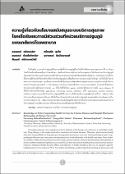บทคัดย่อ
ในปัจจุบัน ระบบบริการปฐมภูมิมีบทบาทเพิ่มขึ้นในการดูแลผู้ป่วยโรคเรื้อรังที่สามารถควบคุมอาการได้ การรักษาโรคเรื้อรังเกือบทั้งหมดเป็นการรักษาด้วยยา ดังนั้นเภสัชกรควรมีส่วนร่วมในการดูแลการใช้ยาในหน่วยบริการปฐมภูมิ โดยเภสัชกรควรมีความเข้าใจเชิงระบบเพื่อให้สามารถทำงานร่วมกับทีมได้อย่างมีประสิทธิภาพ และเนื่องจากโรคเรื้อรังที่มีการส่งผู้ป่วยกลับไปรับบริการที่หน่วยบริการปฐมภูมิมากที่สุดคือเบาหวานและความดันโลหิตสูง ดังนั้นจึงมีนโยบายจากกระทรวงสาธารณสุข และมีงบประมาณหลักที่สนับสนุนการพัฒนาศักยภาพบุคลากรและระบบบริการจากสำนักงานหลักประกันสุขภาพแห่งชาติ การประเมินผลการดำเนินการเน้นตัวชี้วัดกระบวนการและผลลัพธ์ สำหรับตัวชี้วัดด้านยาประเมินจากอัตราผู้ป่วยเบาหวานอายุ 40 ปีขึ้นไปที่ได้รับยา aspirin และอัตราผู้ป่วยเบาหวานที่มี micro albumin ที่ได้รับการรักษาด้วยยากลุ่ม angiotensin converting enzyme inhibitors หรือ angiotensin receptor blockers เภสัชกรควรดูแลระบบยาที่หน่วยบริการปฐมภูมิให้มีรายการยาที่เพียงพอในการดูแลผู้ป่วยโรคเรื้อรัง พัฒนาการจัดบริการและศักยภาพบุคลากรเรื่องยา เป็นที่ปรึกษาเรื่องยาสำหรับหน่วยบริการปฐมภูมิ ตลอดจนมีส่วนร่วมกับพยาบาลในการบริหารจัดการโรค พัฒนาระบบการส่งต่อ-ส่งกลับข้อมูลเกี่ยวกับการใช้ยาระหว่างโรงพยาบาลแม่ข่ายและหน่วยบริการปฐมภูมิ และพัฒนาระบบการเก็บและประมวลผลข้อมูลตามตัวชี้วัดที่กำหนด
บทคัดย่อ
Currently, primary care expands its role for patients with chronic care who have a controlled condition.
Drug therapy is the major method for treatment of chronic diseases. Therefore, pharmacists should
take their responsibility in drug therapy management in primary care unit. Understanding of policy supporting
health services is necessary for pharmacists to work efficiently with health care team. Since diabetes
mellitus (DM) and hypertension are the most common chronic diseases that hospitals refer patients to
receive further treatment at primary care unit (PCU), there are several health policies and financial mechanisms
by National Health Security Office and Ministry of Public Health as the way to support capacity
building and service system in PCU. For system monitoring, quality indicators focusing on processes and outcomes have been developed. The specified prescribing quality indicators for secondary prevention
included prescribing rate of aspirin in DM patients aged at least 40 years and prescribing rate of angiotensin
converting enzyme inhibitors or angiotensin receptor blockers in DM patients with
microalbuminuria. Pharmacists should ascertain that drug items in PCU are optimum for providing care
for patients with concomitant diseases. Drug service system should be improved and health care personnel
in PCU should be trained for basic drug therapy management. Pharmacists should work with the
disease manager nurses to develop referral system for medication history information between the contracting
unit and its’ PCUs. In addition, data collection and data processing system for specified quality
indicators should be developed.


